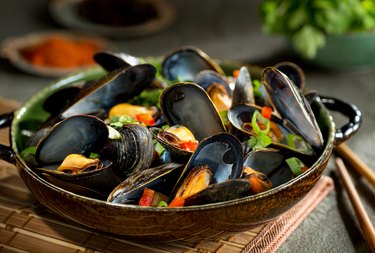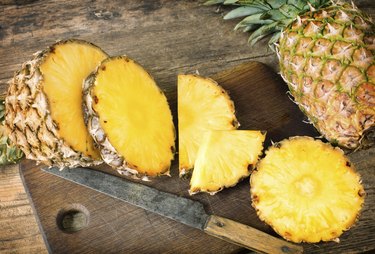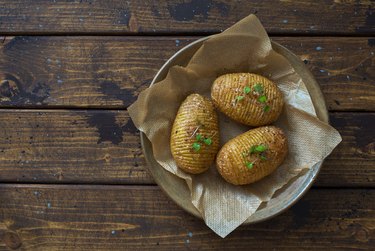Manganese isn't the most well-known nutrient out there, yet it's an essential trace element that supports many processes in your body.
Manganese helps different enzymes in your body work properly, and these enzymes help with things like breaking down food for energy, bone formation, immune response and reproduction, according to the National Institutes of Health (NIH). The mineral helps scavenge free radicals, acting as an antioxidant, and is also involved in blood clotting along with vitamin K.
Video of the Day
Video of the Day
How Much Manganese Do You Need Per Day?
People assigned female at birth ages 19 and up need 1.8 milligrams of manganese per day while people assigned male at birth ages 19 and up need 2.3 milligrams, per the NIH.
The National Academy of Sciences established a tolerable upper intake of manganese at 11 milligrams for adults 19 years and older — but there is no concern for manganese toxicity from foods. Similarly, manganese deficiency is rare, per Oregon State University.
Eating whole-food sources of manganese is the best way to get the mineral, so add these foods rich in manganese to your shopping cart. Note that the DV percentages below are based on an intake of 2.3 milligrams of manganese per day.
1. Blue Mussels: 5.8 mg, 251% Daily Value (DV)

Mussels outrank all other foods by far when it comes to manganese content. Just 3 ounces of cooked blue mussels provides 251 percent of the DV.
Try steaming them with white wine for a delicious dinner protein.
2. Hazelnuts: 1.8 mg, 76% DV
Hazelnuts are the second-best source of manganese in the food supply. One ounce provides 76 percent of the DV — this is about how much you can hold in a small handful, making it easy to get over 100 percent of your intake during snacktime.
3. Pecans: 1.3 mg, 56% DV
Pecans are another one of the best foods high in manganese. Just 1 ounce of pecan halves, or about ¼ cup, has 56 percent of the DV for manganese.
Pecans contain the highest antioxidant content compared to other nuts and seeds, according to a January 2010 research article in the Nutrition Journal. This makes them an excellent choice for snacking or for topping salads and oatmeal.
4. Brown Rice: 1.1 mg, 47% DV
A 1/2 cup of cooked brown rice has 47 percent of the DV for manganese. Brown rice is a whole grain high in fiber. And people who eat the most fiber are observed to have a lower risk of developing type 2 diabetes because it helps slow your blood sugar response, according to a March 2020 review in Nutrients.
In addition, fiber from foods like brown rice can also help lower cholesterol levels, body weight and inflammation as well as support your gut microbiome.
5. Pacific Oysters: 1 mg, 45% DV

In addition to mussels, other seafood like oysters give you nearly half of your manganese needs: 3 ounces of cooked Pacific oysters contain 45 percent of the DV.
Oysters are known for being extremely mineral-rich — they're one of the highest sources of minerals like selenium and zinc in the food supply.
6. Clams: 0.9 mg, 37% DV
Clams are another type of seafood that's a good source of manganese. Three ounces of cooked clams gives you 37 percent of the DV.
Clams are perhaps most known for being a part of traditional clam chowder, but you can also steam or grill them, then season as desired for a tasty and nutritious meal.
7. Chickpeas: 0.8 mg, 37% DV
Also known as garbanzo beans, cooked chickpeas provide 37 percent DV for manganese in just a 1/2 cup. This serving size also offers 7 grams of protein, 6 grams of fiber and only 134 calories and 2 grams of fat. Chickpeas are also a good source of B vitamins.
8. Spinach: 0.8 mg, 37% DV
A 1/2 cup serving of cooked spinach contains 37 percent DV for manganese. Because leafy greens like spinach cook down in size significantly, you may need to start with about 5 cups, or a 5-ounce bag, of raw spinach to produce 1/2 cup cooked.
Use cooked spinach in things like soups, casseroles or scrambled eggs.
9. Pineapple: 0.8 mg, 33% DV

A 1/2 cup of raw pineapple chunks contains 33 percent DV. Not only is pineapple delicious, but it also provides a natural source of the enzyme bromelain, which helps digest proteins.
Bromelain is also linked to helping relieve osteoarthritis, supporting digestion and helping your skin and tissues heal, per the Cleveland Clinic.
10. Soybeans: 0.7 mg, 31% DV
A 1/2 cup of boiled soybeans, also known as edamame, provides 31 percent DV for manganese. Edamame is also a great vegan and vegetarian source of protein, with 16 grams per 1/2-cup serving. This makes them ideal to add to plant-based meals, such as stir-fries, grain bowls and more.
11. Oatmeal: 0.7 mg, 30% DV

A standard of 1/2 cup serving of cooked oatmeal contains 30 percent DV of manganese. Whole grains such as oats are linked to a lower risk of chronic conditions like heart disease, diabetes, obesity and digestive disorders thanks to the beta-glucan fiber they contain, according to the Harvard T. H. Chan School of Public Health.
Oatmeal isn't just for the morning, and it doesn't have to be sweet. Try these savory oatmeal recipes for any time of day.
12. Whole-Wheat Bread: 0.7 mg, 30% DV
Just one slice of standard whole-wheat bread gives you 30 percent DV of manganese. And because it's common to enjoy two slices for a sandwich or toast, you can easily get over half of your daily needs of manganese from this whole grain.
13. Black Tea: 0.5 mg 23% DV
Green tea may get most of the hype, but black tea possesses a lot of health benefits as well. One cup of brewed black tea provides 23 percent DV for manganese, and it is also a great source of antioxidants. In fact, a September 2001 study in the Journal of Nutrition found that black and green tea offer up equally effective antioxidants.
14. Lentils: 0.5 mg, 21% DV
Lentils are another excellent plant-based source of manganese: A 1/2 cup of cooked lentils provides 21 percent DV. Like edamame, lentils are a good vegetarian and vegan source of protein and fiber. This same 1/2 cup serving will give you 9 grams of protein and 8 grams of fiber, all for just over 100 calories.
15. Banana: 0.4 mg, 16% DV
Alongside pineapple, banana is another manganese fruit to add to your diet. One large banana boasts 15 percent of your DV plus 3.5 grams of fiber and some potassium. Add them to smoothies or try them in these tasty banana recipes.
16. Baked Potato: 0.3 mg, 14% DV

Sweet potatoes don't steal the entire show when it comes to nutrients. One medium baked potato with the skin on provides 14 percent DV for manganese.
Baked potatoes are also an excellent source of potassium, with 20 percent DV. Eating foods that are high in potassium can help lower blood pressure by easing tension in the walls of your blood vessels and by counteracting the effects of sodium in the body, according to the American Heart Association.
- National Institute for health: Manganese Fact Sheet for Health Professionals
- FDA: Daily Value on the New Nutrition and Supplement Facts Labels
- Nutrition Journal: The Total Antioxidant Content of More Than 3100 Foods, Beverages, Spices, Herbs and Supplements Used Worldwide
- Nutrients: Dietary Fiber, Gut Microbiota, and Metabolic Regulation—Current Status in Human Randomized Trials
- Harvard T.H. Chan School of Public Health: Aquatic Foods
- Nutrition Source from Harvard T. H. Chan School of Public Health: Oats
- Journal of Nutrition: Theaflavins in Black Tea and Catechins in Green Tea are Equally Effective Antioxidants
- American Heart Association: How Potassium Can Help Control High Blood Pressure
Was this article helpful?
150 Characters Max
0/150
Thank you for sharing!
Thank you for your feedback!